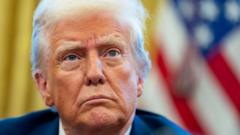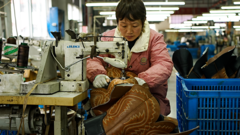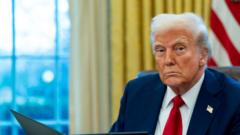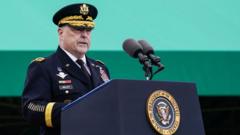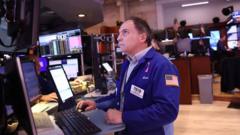The Chancay megaport, inaugurated by Chinese President Xi Jinping, marks a strategic development that positions China as a key player in Latin America while U.S. relations remain uncertain. This $3.5 billion investment by China's state-owned Cosco Shipping is expected to create alternative trade routes that bypass North America entirely, reshaping economic interactions across the region.
China Expands Trade Presence in Latin America with New Megaport
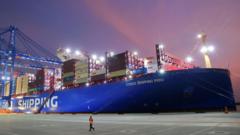
China Expands Trade Presence in Latin America with New Megaport
As China fortifies its influence in Latin America amid shifting U.S. policies, the newly inaugurated Chancay megaport in Peru signals a transformative trade route for the region.
The port, located on Peru's coast, has transformed a once-quiet town into a logistical hub set to facilitate trade from neighboring countries, enhancing the accessibility of Asia's vast market. As regional economies like Brazil and Chile eye new avenues for their exports, concerns over U.S. influence persist, especially as military leaders warn of potential dual-use capabilities at the port.
Despite the apprehensions, analysts note that Latin American nations are finding their interests aligned with China’s Belt and Road Initiative, forcing the U.S. to reconsider its approach or fall behind in its own backyard. With the political landscape changing under the incoming Trump administration, regional countries must navigate the complexities of their relationships with both global powers.
In this evolving scenario, Latin America seeks a more strategic and cooperative framework that moves beyond binary choices between China and the U.S., reflecting its aspirations for economic growth and sovereignty.
The Chancay megaport’s inauguration signifies a turning point for Latin America, as it grapples with the implications of a reconfigured geopolitical landscape amid growing competition between superpowers.
Article text:
As the geopolitical dynamics shift with the anticipated return of Donald Trump, China has taken a bold step to solidify its presence in Latin America with the inauguration of the Chancay megaport on the Peruvian coast. This Chinese-built infrastructure, valued at $3.5 billion and championed by state-owned Cosco Shipping, is set to reshape trade routes and significantly enhance economic opportunities for the region.
The significance of this port was underscored by Xi Jinping’s personal attendance at the ceremony, coinciding with the Asia-Pacific Economic Cooperation (APEC) summit in Peru. "Chancay stands as a nodal point connecting to the colossal Asian market," expressed Peru’s President Dina Boluarte, echoing sentiments reflected by China's state media that lauded the development as a testament to productive cooperation.
With operational capabilities designed to accommodate larger vessels, Chancay is expected to facilitate not only exports from Peru but also imports that could impact domestic industries wary of Chinese goods flooding the market. Initial projections suggest that goods from neighboring nations such as Chile and Brazil will soon find their way to Asian markets via Chancay, demonstrating a shift in the traditional trade paradigms that have long favored North America.
This rapid expansion of Chinese influence comes amid mounting concerns in the U.S. The Chancay port’s capacity for handling ultra-large container vessels raises alarms among military officials, with retired General Laura Richardson cautioning about potential dual-use scenarios that could benefit China's military presence in the Americas.
For many observers, this advancement underscores a reality where America's neglect of Latin American interests has paved the way for Chinese engagement. "China has been proactive where the U.S. has been absent, leading to a complete reconfiguration of relationships in the past ten years," stated Monica de Bolle, a fellow at the Peterson Institute.
As the incoming Trump administration prepares to navigate its foreign policy, regional leaders will be watching closely, especially in light of potential renegotiations of trade agreements, including the pivotal United States-Mexico-Canada Agreement. As the region balances its ties, experts predict that countries will be hesitant to choose sides unless forced.
Ultimately, the Chancay megaport presents both challenges and opportunities for Latin America, prompting a need for strategic cohesiveness to harness the benefits while managing the complexities of shifting allegiances and economic dependencies. Eric Farnsworth, vice-president at the Council of the Americas, emphasizes the need for the U.S. to revitalize its engagement, implying that a robust alternative could sway regional choices favorably back to Washington, if such an option emerges.
Despite the apprehensions, analysts note that Latin American nations are finding their interests aligned with China’s Belt and Road Initiative, forcing the U.S. to reconsider its approach or fall behind in its own backyard. With the political landscape changing under the incoming Trump administration, regional countries must navigate the complexities of their relationships with both global powers.
In this evolving scenario, Latin America seeks a more strategic and cooperative framework that moves beyond binary choices between China and the U.S., reflecting its aspirations for economic growth and sovereignty.
The Chancay megaport’s inauguration signifies a turning point for Latin America, as it grapples with the implications of a reconfigured geopolitical landscape amid growing competition between superpowers.
Article text:
As the geopolitical dynamics shift with the anticipated return of Donald Trump, China has taken a bold step to solidify its presence in Latin America with the inauguration of the Chancay megaport on the Peruvian coast. This Chinese-built infrastructure, valued at $3.5 billion and championed by state-owned Cosco Shipping, is set to reshape trade routes and significantly enhance economic opportunities for the region.
The significance of this port was underscored by Xi Jinping’s personal attendance at the ceremony, coinciding with the Asia-Pacific Economic Cooperation (APEC) summit in Peru. "Chancay stands as a nodal point connecting to the colossal Asian market," expressed Peru’s President Dina Boluarte, echoing sentiments reflected by China's state media that lauded the development as a testament to productive cooperation.
With operational capabilities designed to accommodate larger vessels, Chancay is expected to facilitate not only exports from Peru but also imports that could impact domestic industries wary of Chinese goods flooding the market. Initial projections suggest that goods from neighboring nations such as Chile and Brazil will soon find their way to Asian markets via Chancay, demonstrating a shift in the traditional trade paradigms that have long favored North America.
This rapid expansion of Chinese influence comes amid mounting concerns in the U.S. The Chancay port’s capacity for handling ultra-large container vessels raises alarms among military officials, with retired General Laura Richardson cautioning about potential dual-use scenarios that could benefit China's military presence in the Americas.
For many observers, this advancement underscores a reality where America's neglect of Latin American interests has paved the way for Chinese engagement. "China has been proactive where the U.S. has been absent, leading to a complete reconfiguration of relationships in the past ten years," stated Monica de Bolle, a fellow at the Peterson Institute.
As the incoming Trump administration prepares to navigate its foreign policy, regional leaders will be watching closely, especially in light of potential renegotiations of trade agreements, including the pivotal United States-Mexico-Canada Agreement. As the region balances its ties, experts predict that countries will be hesitant to choose sides unless forced.
Ultimately, the Chancay megaport presents both challenges and opportunities for Latin America, prompting a need for strategic cohesiveness to harness the benefits while managing the complexities of shifting allegiances and economic dependencies. Eric Farnsworth, vice-president at the Council of the Americas, emphasizes the need for the U.S. to revitalize its engagement, implying that a robust alternative could sway regional choices favorably back to Washington, if such an option emerges.




